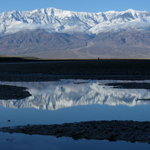Fish in Death Valley? Pupfish no less. The very idea of pupfish is so adorable you wonder why they don't have their own YouTube channel. These little fish live only in the salty creeks and ponds of Death Valley, and they were something we really weren't expecting.
 |
| Salt Creek: Home of the Pupfish |
Like a lot of National Parks, Death Valley has a number of roadside easy -to-access-point -of-interest stops with interpretive displays and very little walking. Our plan was to check all of those out, the pupfish at Salt Creek being the first stop, get the lay of the land, its history, geography and geology. We also wanted to get in our first good hike, hopefully about mid-day at the Golden Hills.
After the Pupfish, which we never saw but it was a nice hike around a running creek that was quite salty, (SD tasted the water and declared it more salty than seawater) we headed south to the Harmony Borax Mine Historical Site. You can't visit the area without talking about mining. Old mine shafts, abandoned mining towns, assorted historical sites, and even a few working mines cover the area. Even before entering the Park we'd stopped at Rhyolite, an abandoned mining town outside Beatty, Nevada. Walls stood alone in fields, rusted cans piled up along the side of old roads, cave openings high in the hills were all the remained of old mine shafts. The graveyard, still accepting occupants, was particularly cool. Of all the abandoned mining towns we'd see in the next few days it was the only graveyard.

Borax mining, on the other hand, didn’t require mine shafts. Miners scrapped the borax off the flats, refined it and shipped it out in huge wagons pulled by twenty mules. The Harmony Borax Mine Historical Site had two of the wagons and a water tank and they really were impressively large.
A mile south of the Borax mine site was the Furnace Creek Interpretive Center. It was our first encounter with the bus tourist. A bus-full of people who are driven from stop to stop, descend on a site, and then as if by magic disappear back into the bus and leave. But the Center was also loaded with great displays and we spent about an hour learning history and geology.
After a full morning of touring and studying we were ready for some hiking but when we arrived at the parking lot for the Golden Hills it was packed and there wasn’t a space available. According to the guide book it was a spectacular but narrow trail.
Craving a bit of desert solitude we drove on, turning left onto a side road about two miles south. That road went east for about a mile then abruptly stopped. Other than a no camping sign there were no signs but a faint path left the road, curved to the east south east and into a canyon wash. I’d read that like Utah, most of the Death Valley trails were walks up canyons and that really you could just pick any canyon and walk up it. With a dedicated parking lot I figured this was as good a canyon as any.... after the hike I suspect it was better than most.
 |
| It's hard to see, but the rocks further down are green and red. |
The wash, or the sand and gravel that wash out of the canyon opening was about half a mile long. After that the canyon walls narrowed quickly. We twisted up and south and south east under smooth walls of white, red and sometimes green rock. Looking at the topographic map it looked like our canyon was running into the Artist Hills, an area renowned for its colorful layered rocks. The further in we hiked the more colorful the rocks became and the closer we through we were to topping out at a pass. Two times we explored side canyons hoping to reach an overlook. But it’s funny in these canyons, you are hiking up but at the same time you are hiking in. They rarely top out. Like the little side canyons most end at a high canyon wall or a "fall", a large rock fall inside the canyon that blocks any further progress. We hiked in for an hour and a half, and although the temptation to go around one more corner was strong, we eventually turned around.
It had been a great first day, from pupfish to historical sites to a great hike, the desert was starting to work its magic.








